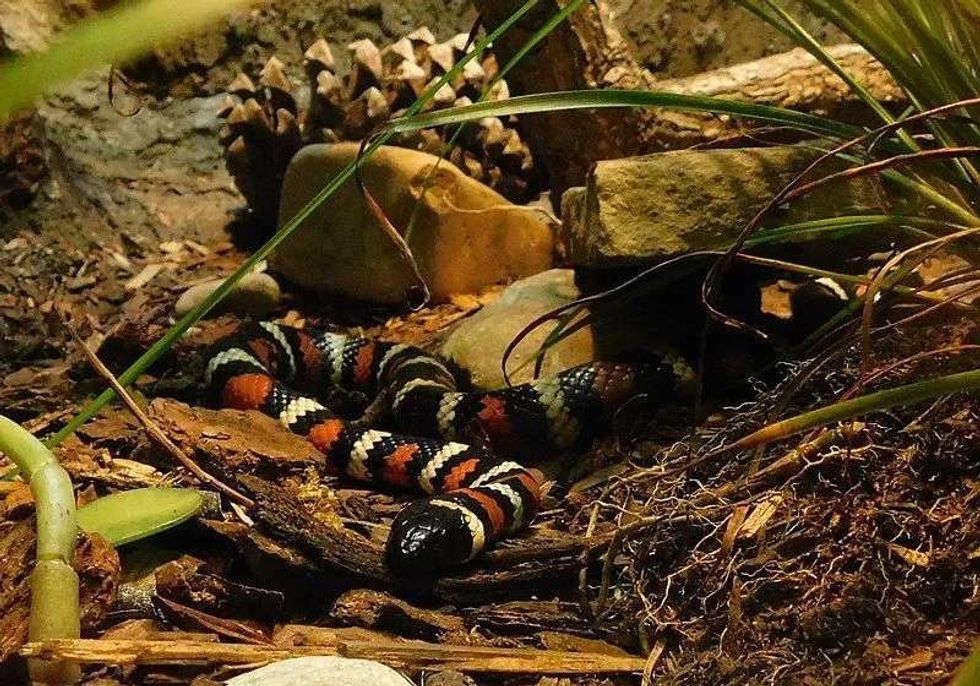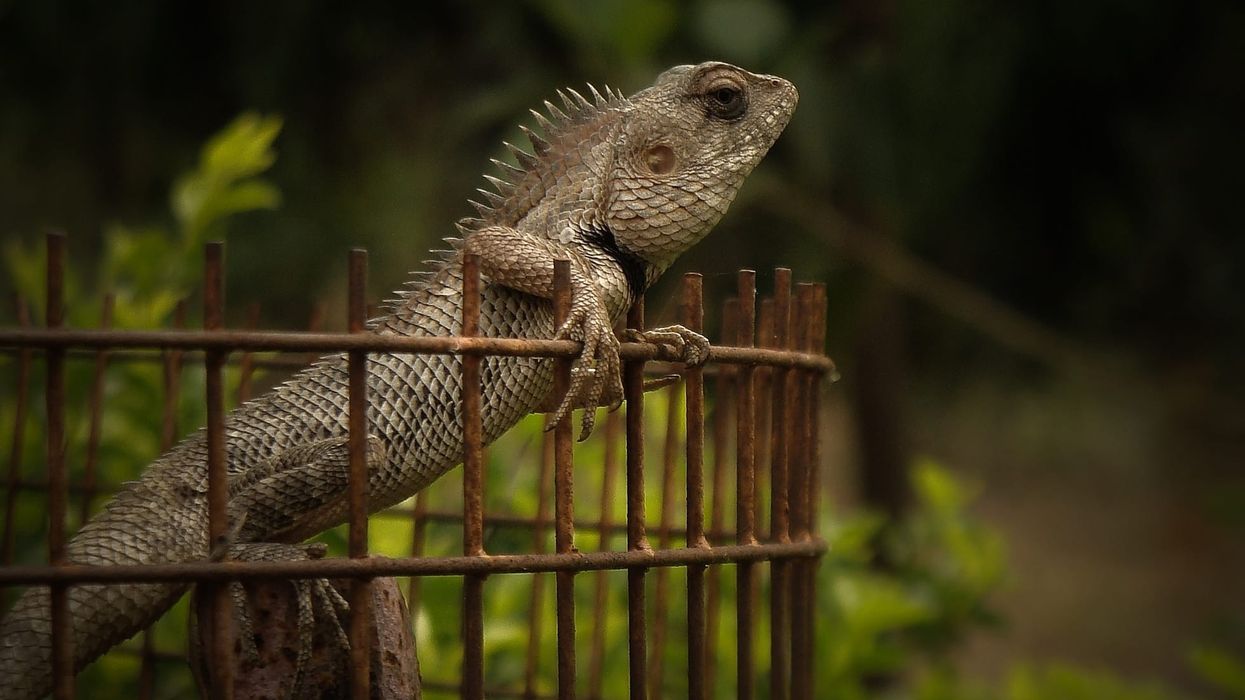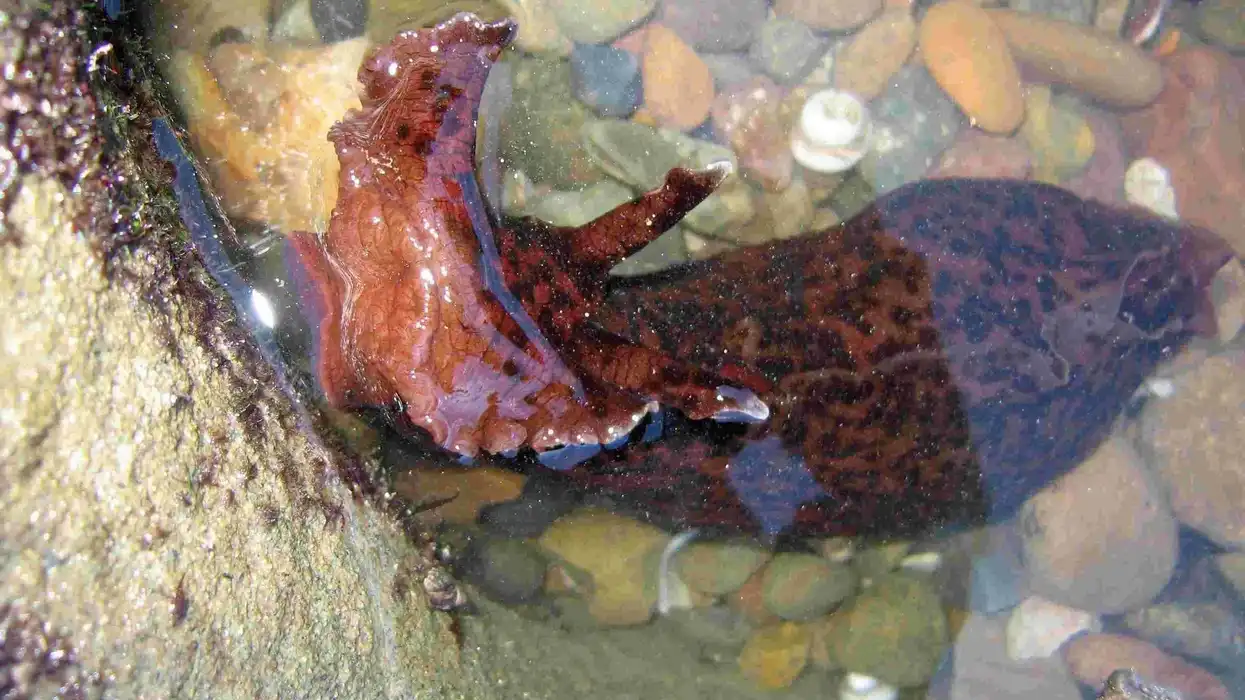Are you fond of learning about bright and colorful snakes? If yes, then come along to know about an interesting snake species called the California mountain kingsnake.
These species of kingsnakes look eerily similar to the venomous coral snakes but are, in fact, nonvenomous in nature. It is distinctly known for the red, blackish, and white patterned bands present on it.
Looking at the bands and pattern on its body, a person can take it as a species with venom, and its predators make the same mistake.
The bands and coloration of its body are uniform as the red bands are always surrounded by two black bands. Apart from the coral snake, the California mountain kingsnakes also look similar to the California kingsnake except for the coloration.
This snake species is extant to western North America, and it is mainly found in the western side of the U.S and Mexico. Baja California, Mexico, has a considerable population of these reptiles along with having some subspecies.
In the western U.S, you can find the California mountain kingsnakes in the states of Washington, Oregon, and California. Their native habitat is in the mountains, and they like to stay inside rock crevices or rotting logs.
The snake has a carnivorous diet that includes everything from small mammals to other snakes. This species is active mainly during the spring and summer seasons while it overwinters in rock crevices during the winter months.
Reproduction takes place by laying eggs. A sad thing about this snake is its diminishing population which has mainly taken place due to habitat destruction.
Are you interested in learning more about this species? Keep reading for interesting California mountain kingsnake facts! For more relatable content, check out these thorny devil facts and anaconda snake facts for kids.
California Mountain Kingsnake Interesting Facts
What type of animal is a California mountain kingsnake?
The California mountain kingsnake (Lampropeltis zonata) is a nonvenomous snake species belonging to the Colubridae family.
What class of animal does a California mountain kingsnake belong to?
The California mountain kingsnake (Lampropeltis zonata) belongs to the class Reptilia and to the genus Lampropeltis.
How many California mountain kingsnakes are there in the world?
It is hard to tell the population of this snake species, but the IUCN notes that it is anywhere between 10,000-100,000 individuals. Tracking the population of this kingsnake is hard because of its secretive nature.
Where does a California mountain kingsnake live?
The California mountain kingsnakes are extant to the United States and Mexico. In the U.S, these snakes are found in Washington, Oregon, and California. In Mexico, the population of this snake is concentrated in Baja, California. You can easily understand that the snake has been named after its native place of California.
What is a California mountain kingsnake habitat?
The California mountain kingsnakes are known for having varied habitats. However, the snakes are most often seen in moist woodlands that include vegetation like coniferous forests, oak woodlands, and chaparral.
This species has an affinity towards rocks and crevices found in the mountains. It can also be found in the south-facing slopes of the stream canyons present in the mountains. These kingsnakes are usually seen in a habitat with an elevation of up to 9842.5 ft (3000 m).
Who does California mountain kingsnake live with?
The secretive nature of these snakes prevents us from knowing a lot about their lifestyle. However, like other snake species, the California mountain kingsnake is most likely a solitary animal that comes in touch with members of its species only during the breeding season.
How long does a California mountain kingsnake live?
The average lifespan of the California mountain kingsnake (Lampropeltis zonata) is around 10-15 years in the wild. In captivity, most of the snakes have successfully survived for a maximum of 15 years.
How do they reproduce?
Reproduction is one of the most interesting aspects of the life of these snakes. In the wild, to proceed towards mating, the males follow pheromone trails laid down by the females.
While in captivity, the males generally move towards places where the females lay coiled. The mating season lasts from April to early June, although some snakes may mate even in March.
The females only lay one clutch of eggs per year from May to July. The clutch has an average of 2-10 eggs, seven being the most common clutch size.
Females lay elongated white eggs that adhere to each other. The incubation period for the eggs lasts between 47-87 days, and the parent snakes have no involvement in taking care of the baby animals.
What is their conservation status?
According to the International Union for Conservation of Nature (IUCN) Red List, the California mountain kingsnakes have the current status of Least Concern. Despite that, the population of these kingsnakes has been on the decline, majorly because of habitat destruction. Moreover, these bright and colorful nonvenomous snakes are also poached to sell as pets.
California Mountain Kingsnake Fun Facts
What does the California mountain kingsnake look like?
We cannot talk about the California mountain kingsnake (Lampropeltis zonata) without mentioning its beauty. This snake has evolved with the perfect coloration to mimic the coral snake group.
Similar to the coral snake, it has red, black, and white bands on its body. It is said to be a tricky getup to ward off predators. The body of this snake has uniform red bands that are surrounded by two black bands followed by white bands.
These snakes may look just as yummy as candy corns, but you are not supposed to eat them! The bright red, black, and white coloration of these North American snakes help in hunting.
The red bands might not be present in some individuals, but it is a rarity. Others may have hints of yellow bands. A variety of the species Lampropeltis zonata that lives in Isla Todos Santos only sports black and white bands instead of the bright red.
The species Lampropeltis zonata (California mountain kingsnake) has a medium to long body length and is cylindrical in shape. The scales on the body surface of this snake are smooth and unkeeled.
There are no differences between the two sexes. However, females can have lesser subcaudals. The chin of this snake is often white, while the dorsal side of its head is black.

How cute are they?
Everyone may not agree with the fact that snakes can be deemed cute. Instead, we can say that these majestic reptiles have a charm of their own.
How do they communicate?
Snakes are quite interesting and one of the most striking things about these reptiles has to be the communication style. Scents are important to snakes as it helps in tracking the smell of prey and in searching for mates.
The California mountain kingsnakes look similar to the venomous coral snake because of their red, black, and white coloration. Its bright look and banded pattern can certainly keep away predators.
How big is a California mountain kingsnake?
California mountain kingsnakes are medium-sized snakes with an average length that ranges between 20-48.2 in (51-122.5 cm). The California mountain kingsnakes are certainly smaller in length than the common kingsnakes that have an average length of 36-60 in (91.4-152.4 cm); this snake also belongs to North America.
How fast can a California mountain kingsnake move?
We are yet to know more about the speed ranges of California mountain kingsnakes, but it should be noted that these are rather slow-moving creatures.
How much does a California mountain kingsnake weigh?
Not much is known about the average weight of the species California mountain kingsnakes (Lampropeltis zonata) except that they weigh more than 3.5 oz (100 g).
What are the male and female names of the species?
There are no separate names for the male and female California mountain kingsnakes.
What would you call a baby California mountain kingsnake?
The babies of California mountain kingsnakes are called hatchlings.
What do they eat?
These animals are carnivorous in nature, so the California mountain kingsnake diet mainly consists of lizards, birds, eggs of lizards and birds, as well as small mammals. It is an opportunistic hunter and kills its prey by using pressure on the animals.
The diet of the California mountain kingsnake consists mainly of terrestrial vertebrates. Some of the reptiles eaten include Gilbert skinks, sagebrush lizards, and western fence lizards.
Are they poisonous?
No, this is not a venomous snake. The bright color of the California mountain kingsnakes gives a similar look to venomous snakes, but it doesn't produce any toxin and is a nonvenomous snake.
Its bright color can be a way to deter predators from attacking. Even though the California mountain kingsnake won't be able to kill you, it can surely bite if it is irritated. However, they aren't aggressive animals, and they try to stay away from human beings as much as possible.
Would they make a good pet?
Even though this snake is kept as a pet by many because of its unique body pattern, we will suggest you steer clear from getting it. These snakes are meant to live in rock crevices of the mountain and are not great at adapting to human households.
Did you know...
California mountain kingsnakes have seven subspecies: Lampropeltis zonata multicincta, Lampropeltis zonata multifasciata, Lampropeltis zonata parvirubra, Lampropeltis zonata pulchra, Lampropeltis zonata agalma, Lampropeltis zonata zonata, and Lampropeltis zonata herrerae. Among these, the San Diego mountain kingsnake subspecies are the most noted and are found in southern California.
There is a debate about the differences present between the subspecies, but the pattern of contrasting bands is present in the snakes.
In Oregon, the California mountain kingsnakes are found in the Rogue River Basin. These snakes are also present in the dry regions of Oregon.
In its habitat in the mountains, this species can be seen basking under the sun on warm summer days. The red and black-looking Lampropeltis zonata (California mountain kingsnake) is active during the day in spring and fall, while it may turn crepuscular or nocturnal during the hot summer days.
As this snake dwells in wooded habitat in the mountains of North America, it has also grown a habit of climbing trees.
What is the most venomous snake in the world?
The inland taipan is considered to be the most venomous snake in the world. It resides in central east Australia.
Can a king snake kill a rattlesnake?
Yes, some kingsnakes are able to kill rattlesnakes as they are immune to the venom. They kill the snakes by the exertion of pressure.
Here at Kidadl, we have carefully created lots of interesting family-friendly animal facts for everyone to discover! Learn more about some other reptiles from our sea snake facts and Texas horned lizard facts pages.
You can even occupy yourself at home by coloring in one of our free printable California mountain kingsnake coloring page.









